Abstract
Dentigerous cyst is a developmental odontogenic cyst, which develops due to fluid accumulation between the reduced enamel epithelium and unerupted tooth crown. The condition is frequently seen with the permanent dentition, usually associated with impacted mandibular third molars and maxillary canines. Rarely, dentigerous cyst occurs in association with a supernumerary tooth. Pain, swelling, and facial asymmetry are occasionally seen; however, they are usually asymptomatic and observed during radiographic examination. Early diagnosis and treatment planning entails thorough history taking, clinical and radiographic examination coupled with histopathology. This article reports an unusual occurrence of dentigerous cyst of anterior maxillary region seen with an inverted impacted mesiodens cyst enucleation along with extraction of the mesiodens was carried out and no complications were observed during the follow-up.
Keywords: Dentigerous cyst, enucleation, mesiodens
INTRODUCTION
Disruption in the odontogenesis process results in a supernumerary tooth. This may occur from the splitting of the enamel organ or from uncordinated cell proliferation. Exact etiopathogenesis of supernumerary teeth is obscure; however, they may have familial tendencies. Hyperactivity of dental lamina, genetic mutation, dichotomy or environmental factors may also play a contributory role.[1,2] Supernumerary teeth results in a variety of complications such as impaction of adjacent teeth, crowding, spacing, displacement and rotation of teeth, occlusal interferences, caries, periodontal problems, mastication problems, and esthetic concerns.[1,3] Other pathologic features associated with multiple supernumerary teeth are formation of a dentigerous cyst with associated bone destruction, displacement of adjacent teeth, resorption of root, and fistula between oral and nasal cavity.[2,3,4] Dentigerous cysts accounts for one of the most common odontogenic cysts, frequently seen with embedded unerupted teeth, supernumerary teeth, and odontomes. Occurrence of dentigerous cysts with deciduous teeth is a rare phenomenon.[5] Dentigerous cyst occuring in association with supernumerary tooth and mesiodens has been occasionally seen. About 5% of all dentigerous cysts are attributed by the dentigerous cysts with supernumerary teeth. They usually occur in the maxillary anterior region in association with mesiodens.[6] Occurrence of dentigerous cyst with supernumerary teeth was first described by Pitts in 1924,[7] and the association of dentigerous cyst with supernumerary teeth was observed by Lustman and Bodner in 1988.[8] The hallmark is the presence of the unerupted tooth in the cyst cavity.[9] Hereby, presenting a rare case of dentigerous cyst with inverted impacted mesiodens in a 32-year-old-male patient.
CASE REPORT
A 32-year-old male patient reported to the outpatient department with a chief complaint of a painless, slow growing swelling in the maxillary anterior teeth region for the past 6 months. The swelling was initially small in size and had increased with time to attain the present size. There was no associated history of trauma and pain. The medical history was noncontributory. Extra oral examination revealed diffuse swelling in the anterior region of the maxilla. Anteriorly, the swelling extended from the tip of the nose to 2 cm lateral to the left ala of the nose posteriorly, and superiorly extending up to 3 cm inferior to the left inner canthus of the eye, and inferiorly it extended to the lower border of the upper lip. The swelling caused mild deviation of the tip of the nose to the right side with obliteration of the left nasolabial fold. On palpation, the swelling was nontender and firm in consistency [Figure 1]. Intraoral examination revealed a well-defined solitary swelling in the region of the maxillary vestibule measuring 3.5 cm2 × 3 cm2 in size. It extended from 11 to the distal line angle of 23. The swelling obliterated the labial mucobuccal fold superiorly and inferiorly it extended to the region of the alveolar mucosa. The overlying mucosa was intact and of the same color. No surface discharge was seen. The swelling was nontender, firm in consistency at the periphery and yielded to pressure at the center. The maxillary anterior teeth responded positively to vitality tests [Figure 2]. A provisional diagnosis of nasolabial cyst was made. Maxillary occlusal radiograph revealed a well-defined, corticated, unilocular radiolucent lesion extending from 11 to 22 region mediolaterally, and anteroposteriorly, it extended from the apices of the maxillary incisors to a few cm into the palate. Inverted impacted mesiodens was also seen in relation to the maxillary central incisors. The radiolucent lesion circumscribed the cemento-enamel junction of the impacted tooth. Slight resorption of the roots of 11 and 21 was noticed [Figure 3]. A fine-needle aspiration showed blood tinged cystic fluid which revealed cholesterol crystals on examination. After the informed consent of the patient, an incisional biopsy was made under local anesthesia. Histopathological sections revealed odontogenic cystic lining along with connective tissue wall. The cystic lining consists of 2-4 layer thickness of nonkeratinized stratified squamous epithelium. The connective tissue wall resembles dental papillae and shows mild chronic inflammatory cell infiltrate with mild vascularity and areas of hemorrhage, features suggestive of dentigerous cyst [Figure 4]. Dentigerous cyst was considered as the final diagnosis after correlating the history, clinical and radiographical features, coupled with histopathology. Cyst enucleation along with extraction of the supernumerary tooth was considered as the treatment plan; a surgical flap was raised in the maxillary anterior region, the labial cortex was raised and the cyst was exposed [Figure 5]. Macroscopic specimen showed the cystic lumen at the cemento-enamel junction of the supernumerary mesiodens [Figure 6]. Sutures were placed and the patient underwent uneventful healing of the surgical site after 2 weeks. No recurrences were observed during the 6 months follow-up period.
Figure 1.
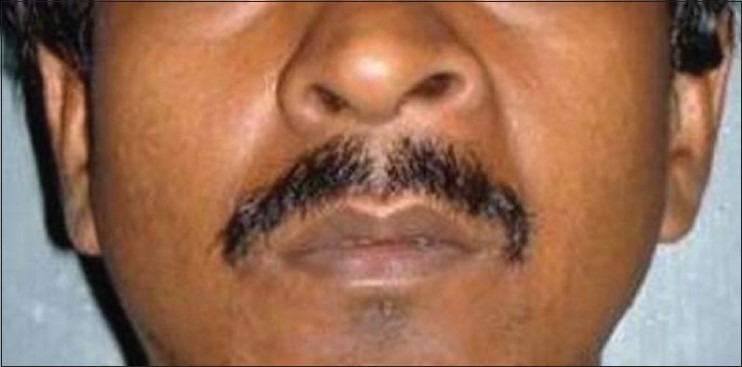
Diffuse extra oral swelling in maxillary anterior region
Figure 2.
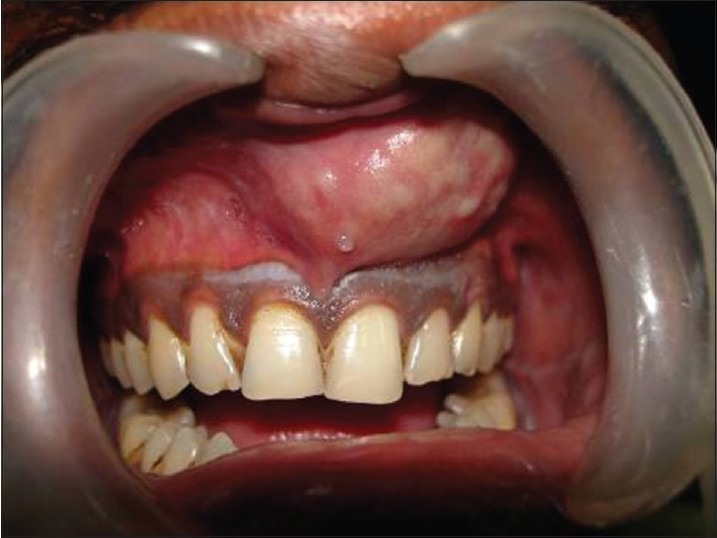
Well-defined localized swelling in the maxillary anterior vestibular region obliterating the labial mucobuccal fold
Figure 3.
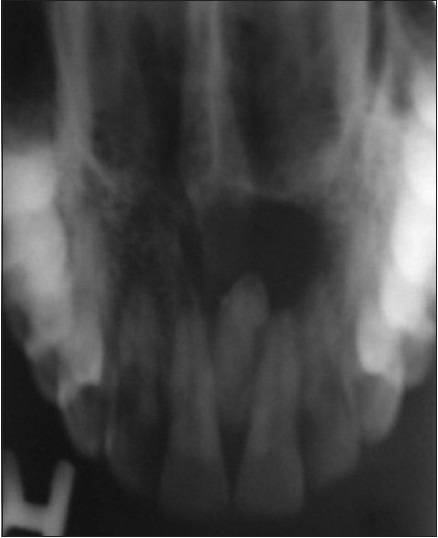
Maxillary occlusal radiograph showing well-defined, corticated radiolucency with an impacted inverted supernumerary tooth
Figure 4.
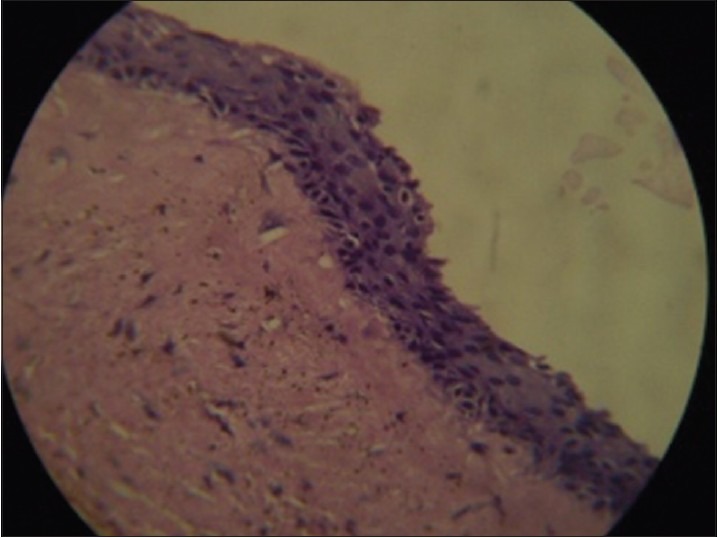
Photomicrograph showing cystic wall with nonkeratinized stratified squamous epithelium
Figure 5.
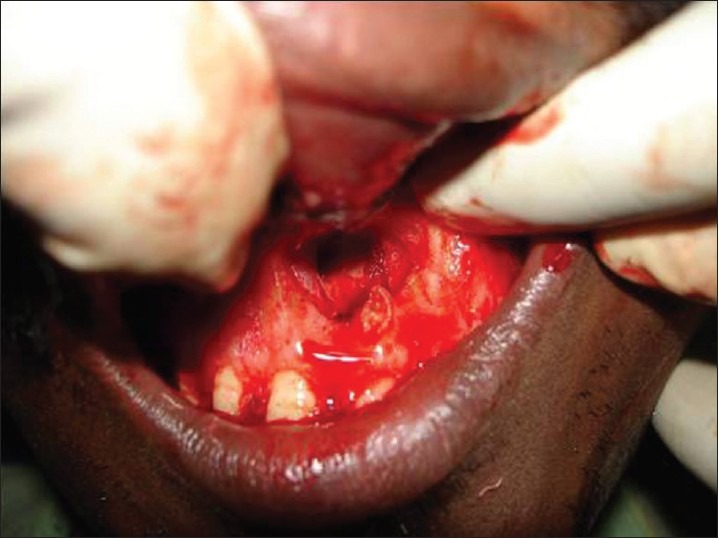
Intra operative procedure with exposed cystic cavity
Figure 6.
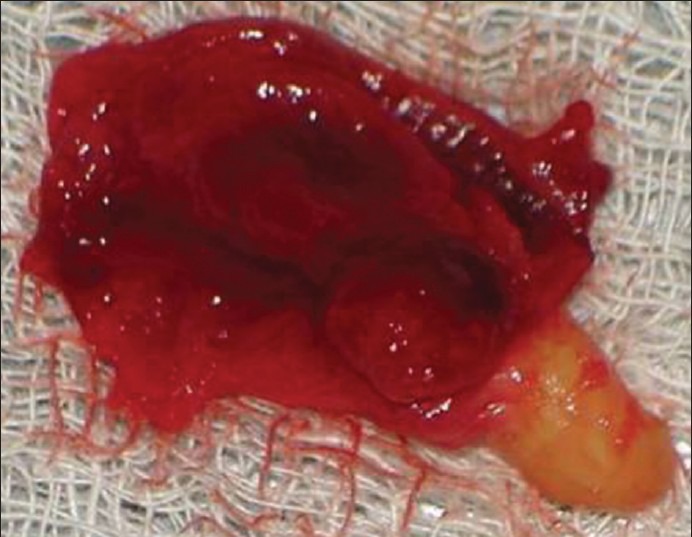
Enucleated cystic lumen along with the supernumerary tooth
DISCUSSION
The term dentigerous means “containing tooth,” and this is the characteristic description of the cyst. A dentigerous cyst surrounds the crown of an unerupted tooth, expands the follicle, and is characteristically attached to the cemento-enamel junction of the unerupted tooth.[10] The cyst usually affects individuals between 10 and 30 years of age, and males are more affected with an incidence rate of 1.6:1.[11] Dentigerous cyst due to supernumerary tooth usually affects the first four decades of life.[9] Dentigerous cysts usually are solitary, however, multiple cysts may be seen with syndromes such as Gardner's syndrome, mucopolysaccharidosis, Maroteaux-Lamy syndrome and basal cell nevus syndrome.[12]
Our patient was a 32-year-old male, who presented with an asymptomatic solitary swelling in the maxillary anterior tooth area.
Benn and Altini[13] proposed three feasible mechanisms for the histogenesis of dentigerous cyst. Developmental dentigerous cyst results from dental follicle, becomes secondarily inflamed, usually from a nonvital tooth. The second type arises when an immature permanent tooth encounters a radicular cyst arising from nonvital deciduous tooth. As the permanent tooth erupts into radicular cyst, it results in dentigerous cyst of extra follicular origin. Third type develops due to inflammatory exudates, usually from peri-apical inflammation from nonvital deciduous tooth or other source.
Radiographically, the dentigerous cyst usually occurs as a well-defined unilocular radiolucency, often with a sclerotic border. As the epithelial lining is derived from the reduced enamel epithelium, this radiolucency, typically and characterstically surrounds the crown of the tooth. A large dentigerous cyst may sometimes resemble a multilocular process, as bone trabeculae may be seen within the radiolucency. However, mostly dentigerous cysts are grossly and histopathologically unilocular processes and probably are never truly multilocular lesions.[14] Three types of dentigerous cyst have been described radiographically: (a) The central variety, in which the tooth crown is enclosed by the radiolucency, and the crown protrudes into the cystic lumen. (b) The lateral variety in which the cyst occurs laterally along the tooth root, thus, partially surrounding the crown. (c) The circumferential variety exists when the cyst not only surrounds the crown, but also extends down along the root surface, thus, giving the impression of the tooth within the cyst.
In this case, a well-defined, corticated, 2 cm2 × 3 cm2 unilocular radiolucent lesion was appreciated in relation to maxillary anterior teeth. Interesting finding of inverted impacted mesiodens projecting into the cystic lesion makes the present case more unusual and worthy to report. The roots of the maxillary central incisors showed slight root resorption, another rare feature with dentigerous cysts.
Hyperplastic follicle should be considered as the main differential diagnosis for dentigerous cyst. Odontogenic keratocyst, ameloblastic fibroma, and cystic ameloblastoma are the other important differential diagnosis.[6]
Histological features seen are fibrous wall with nonkeratinized, stratified squamous epithelial lining and consists of myxoid tissue, odontogenic remnants and occasionally, sebaceous cells. Histological examination accounts for the definitive diagnosis.[15]
Histopathological features in this case, showed 2-4 layer thickness of nonkeratinized stratified squamous epithelium. The connective tissue wall resembles dental papillae and shows mild chronic inflammatory cell infiltrate with mild vascularity and areas of hemorrhage.
Various treatment plans proposed for dentigerous cysts are: (a) Surgically removing the cyst. Consideration should be taken not to damage the associated permanent tooth. (b) Cyst enucleation along with extraction of the involved tooth. (c) Marsupialization technique - involves removal of the cyst, however, the developing tooth is preserved. The offending tooth playa a major role in deciding the type of surgical intervention required for the dentigerous cyst. Complete enucleation of the cysts along with extraction of the tooth forms the mainstay of treatment for the cysts associated with a supernumerary or wisdom tooth. Isolated lesions in young patients, where preservation of the teeth is desirable, marsupialization is the recommended treatment option.[16] Pathological bone fracture, loss of permanent tooth, deformation of bone, ameloblastoma and development of malignancies (squamous cell carcinoma, mucoepidermoid carcinoma) are the frequently associated complications.[17]
Cyst enucleation along with extraction of the inverted impacted supernumerary tooth was the treatment plan considered in the present case. The patient was followed-up for 6 months and the postoperative period was uneventful.
CONCLUSION
Dentigerous cyst is a common developmental odontogenic cyst, mostly seen in relation with impacted mandibular third molars and maxillary canines. Usually, they are asymptomatic and this delays the diagnosis. Prompt diagnosis and treatment is mandatory to prevent dreadful complications.
Footnotes
Source of Support: Nill.
Conflict of Interest: None declared.
REFERENCES
- 1.Taner T, Uzamis M. Orthodontic treatment of a patient with multiple supernumerary teeth and mental retardation. J Clin Pediatr Dent. 1999;23:195–200. [PubMed] [Google Scholar]
- 2.Marya CM, Kumar BR. Familial occurrence of mesiodentes with unusual findings: Case reports. Quintessence Int. 1998;29:49–51. [PubMed] [Google Scholar]
- 3.Garvey MT, Barry HJ, Blake M. Supernumerary teeth: An overview of classification, diagnosis and management. J Can Dent Assoc. 1999;65:612–6. [PubMed] [Google Scholar]
- 4.McDonald JS. Tumors of the oral soft tissues and cysts and tumors of the bone. In: McDonald RE, Avery DR, Dean JA, editors. Dentistry for the Child and Adolescent. 8th ed. St. Louis: Mosby; 2004. pp. 159–61. [Google Scholar]
- 5.Agrawal M, Raghavendra PD, Singh B, Agrawal N. Multiple teeth in a single dentigerous cyst follicle: A perplexity. Ann Maxillofac Surg. 2011;1:187–9. doi: 10.4103/2231-0746.92792. [DOI] [PMC free article] [PubMed] [Google Scholar]
- 6.Dinkar AD, Dawasaz AA, Shenoy S. Dentigerous cyst associated with multiple mesiodens: A case report. J Indian Soc Pedod Prev Dent. 2007;25:56–9. doi: 10.4103/0970-4388.31994. [DOI] [PubMed] [Google Scholar]
- 7.Pitts AT. A Dentigerous cyst apparently associated with a supernumerary tooth. Proc R Soc Med. 1924;17:9–10. [PMC free article] [PubMed] [Google Scholar]
- 8.Lustmann J, Bodner L. Dentigerous cysts associated with supernumerary teeth. Int J Oral Maxillofac Surg. 1988;17:100–2. doi: 10.1016/s0901-5027(88)80159-0. [DOI] [PubMed] [Google Scholar]
- 9.Grover SB, Singh P, Venkatachalam VP, Hekha N. Mesiodens presenting as a dentigerous cyst: Case report. Indian J Radiol Imaging. 2005;15:69–72. [Google Scholar]
- 10.Boyczuk MP, Berger JR, Lazow SK. Identifying a deciduous dentigerous cyst. J Am Dent Assoc. 1995;126:643–4. doi: 10.14219/jada.archive.1995.0243. [DOI] [PubMed] [Google Scholar]
- 11.Regezi AJ, Sciubba JJ, Jordan RC. Oral Pathology: Clinical-Pathologic Correlations. 5th ed. St. Louis: Saunders; 2008. pp. 242–4. [Google Scholar]
- 12.Roberts MW, Barton NW, Constantopoulos G, Butler DP, Donahue AH. Occurrence of multiple dentigerous cysts in a patient with the Maroteaux-Lamy syndrome (mucopolysaccharidosis, type VI) Oral Surg Oral Med Oral Pathol. 1984;58:169–75. doi: 10.1016/0030-4220(84)90133-6. [DOI] [PubMed] [Google Scholar]
- 13.Benn A, Altini M. Dentigerous cysts of inflammatory origin. A clinicopathologic study. Oral Surg Oral Med Oral Pathol Oral Radiol Endod. 1996;81:203–9. doi: 10.1016/s1079-2104(96)80416-1. [DOI] [PubMed] [Google Scholar]
- 14.Shear M, Speight P. Cysts of the Oral and Maxillofacial Regions. 4th ed. Oxford Blackwell Publishing Ltd.; 2007. p. 5978. [Google Scholar]
- 15.Kalaskar RR, Tiku A, Damle SG. Dentigerous cysts of anterior maxilla in a young child: A case report. J Indian Soc Pedod Prev Dent. 2007;25:187–90. doi: 10.4103/0970-4388.37016. [DOI] [PubMed] [Google Scholar]
- 16.Jena AK, Duggal R, Roychoudhury A, Parkash H. Orthodontic assisted tooth eruption in a dentigerous cyst: A case report. J Clin Pediatr Dent. 2004;29:33–5. doi: 10.17796/jcpd.29.1.2380j436055616j4. [DOI] [PubMed] [Google Scholar]
- 17.Chakraborty A, Sarkar S, Dutta BB. Localised disturbances associated with primary teeth eruption. J Indian Soc Pedod Prev Dent. 1994;12:25–8. [PubMed] [Google Scholar]


